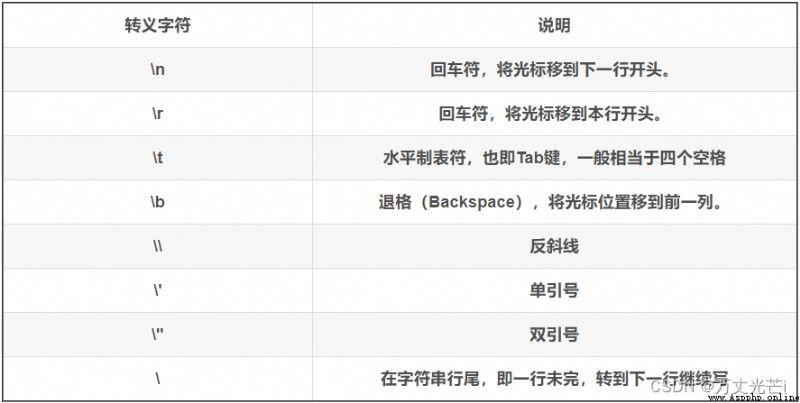I just got started python, So write a summary that is easy to forget , I hope that's helpful . The editor I use is IDLE.
1. One can check all python Operation of functions in
dir(__builtins__)Use interactive mode , Then enter this function , You can come out python All functions .
2. When exchanging two numbers , You can use the following code directly
x,y = y,xThe principle of this and x,y,z = 1,2,3 One principle .
3. stay IDLE in , Press Alt+P It means the last sentence , You can return the code of the previous sentence .
4. Escape characters are those that begin with \ Start character , as follows :

5.""" """: This means that , Whatever is written in it will be output as is .
6. The result of adding characters to characters indicates the connection , for example :
'520' + '1314'The output of is 5201314
7. The result of multiplying a character by a number indicates copying , for example :
' Hey, hey, hey ' * 1000It's copying 1000 I mean
8. Press ctrl + C You can force the execution of a program to stop .
9.break sentence : The function is to jump out of a layer of circular body .
10.import It means import , If we want to generate random numbers at random , Import required random modular .
import random11. The function of random number is ( The latter two numbers represent the range of random numbers ):
random.randint(0,100)This function can be attacked , in other words , Make its number not random , But reappearance .
x = random.getstate()
random.randint(1,10)
8
random.randint(1,10)
6
random.randint(1,10)
2
random.randint(1,10)
10
random.randint(1,10)
3
random.randint(1,10)
2
random.randint(1,10)
6
random.setstate(x)
random.randint(1,10)
8
random.randint(1,10)
6
random.randint(1,10)
2
random.randint(1,10)
10
random.randint(1,10)
3
random.randint(1,10)
2
random.randint(1,10)
6
random.randint(1,10)
4
random.randint(1,10)
8Above , That is to say .
12. Numeric type : Integers , Floating point numbers , The plural
Because of the high precision of floating point numbers , You need to use the following function to add floating-point numbers accurately
a = decimal.Decimal('0.1')
b = decimal.Decimal('0.2')
print(a + b)
0.3It can also be compared :
c = decimal.Decimal('0.3')
a + b == c
True‘E Notation ’ That is what we usually call scientific counting , Used to represent some extreme numbers . for example :
0.00005 == 5e-05The plural : We can go through x.real To get the value of its real part , adopt x.imag To get the value of its imaginary part . A complex number is also a floating point number .
Some operations on numbers :
operation result x//yx Divide y Result ( Floor removal )divmod(x,y) return (x//y,x%y)abs(x)x The absolute value of int(x) take x Convert to integer float(x) take x Convert to floating point number complex(re,im) Returns a complex number ,re Is the set of real Numbers ,im It's an imaginary number c.conjugate() return c The conjugate complex of pow(x,y) Calculation x Of y Power x ** y Calculation x Of y PowerWhat is the floor except ? Is to ensure that the result of dividing two numbers is an integer . If it's not an integer , Just round down ( Take the largest integer smaller than the target result ). for example :
-3 // 2 == -2
3 // 2 == 1Besides ,pow Supports three parameters , In fact, it is equivalent to the power operation of the first two parameters , Take the remainder of the third number , for example :
pow(2,3,5) == 313. Boolean type ( In fact, it is a special integer type )
The result is false The situation of :
(1) Defined as False The object of :None and False
(2) The value is 0 The number type of :0,0.0,0j,Decimal(0),Fraction(0,1)( This means that the molecule is zero , A rational number whose denominator is one )
(3) Empty sequences and sets :'',(),[],{},set(),range(0)